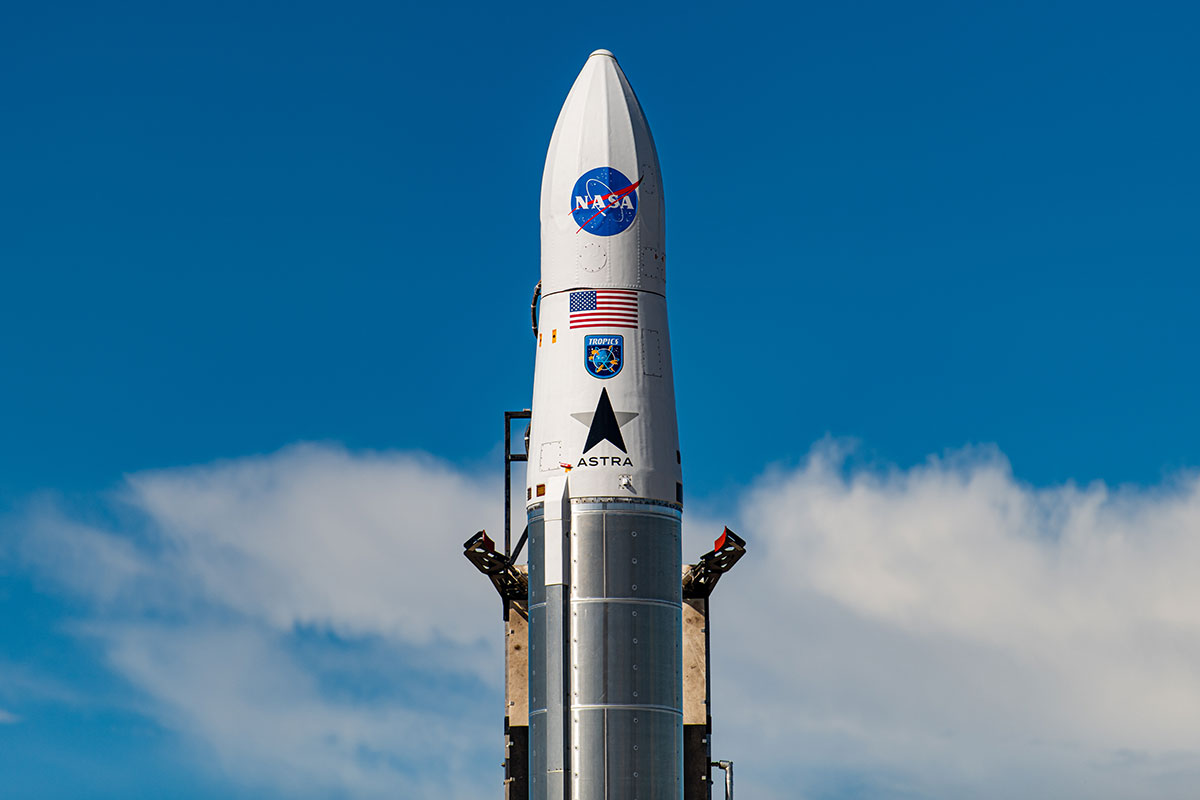
Astra is preparing to launch the first of three straight dedicated missions for NASA this weekend at Cape Canaveral to deploy six shoebox-size hurricane research satellites, helping pioneer a new paradigm of riskier but less expensive science missions.
The commercial launch company, geared toward the burgeoning small satellite industry, won a $7.95 million contract last year to haul NASA’s six TROPICS spacecraft into orbit using three rockets.
The first of the three TROPICS missions is set for liftoff during a two-hour window opening at 12 p.m. EDT (1600 GMT) Sunday. Astra delivered the rocket to Florida’s Space Coast last month, and completed a test-firing of the booster’s five engines at Space Launch Complex 46, a commercially-operated facility near the easternmost extent of Cape Canaveral Space Force Station.
The first two TROPICS satellites are mounted inside a deployer on top of the 43-foot-tall (13.1-meter) Astra launcher, which the company calls Rocket 3.3, or tail number LV0010.
“We’re trying to make improved observations of tropical cyclones,” said William Blackwell, principal investigator for the TROPICS mission from MIT Lincoln Laboratory. “And what we’re really trying to characterize is the fundamental thermodynamic environment around the storm. So that’s things like the temperature, and the amount of moisture and precipitation intensity, and the structure around the storm.
“Those are important variables because they can be related to the intensity of the storm, and even potential for future intensification,” Blackwell said in Friday in an interview with Spaceflight Now. “So we’re trying to make those measurements with relatively high revisit. That’s really the key new feature that the TROPICS constellation provides, is improved revisit of the storms.
“We’ll have six satellites orbiting, and one satellite will work to make a nice image of the storm, and then the next satellite will orbit closely behind it about an hour behind,” Blackwell said. “So we’ll get, roughly every hour, a new image of the storm, and that’s about a factor of five-to-eight better than what we get today. With these new measurements of rapidly updated imagery, we hope that that will help us understand the storm better, and ultimately lead to better forecasting of the hurricane track and intensity.”
TROPICS stands for Time-Resolved Observations of Precipitation structure and storm Intensity with a Constellation of Smallsats. The mission has a total cost of approximately $30 million, according to NASA.
Each TROPICS satellite has a single instrument. A microwave radiometer, about the size of a coffee cup and spinning 30 times per minute, will create images of tropical cyclones, collect temperature measurements, and gather vertical profiles of moisture through the atmosphere.
“NOAA and the Europeans and many others have been flying passive microwave radiometers for decades, and these are big, expensive instruments,” Blackwell said. “What we’ve done with TROPICS is miniaturize the electronics to make them much smaller.
“The entire satellite for TROPICS, one of them weighs about 10 pounds, and is about the size of a loaf of bread,” Blackwell said. “So these are relatively inexpensive to build and test, and we can make them fairly rapidly, and they’re relatively inexpensive to launch.”
The TROPICS satellites were built by Blue Canyon Technologies in Boulder, Colorado. Their small size makes them a good fit for Astra, which can deliver about 110 pounds (50 kilograms) of payload to a 310-mile-high (500-kilometer) orbit.
Email the author.
Follow Stephen Clark on Twitter: @StephenClark1.
from Spaceflight Now https://ift.tt/2EMftIw
via World Space Info







0 comments:
Post a Comment